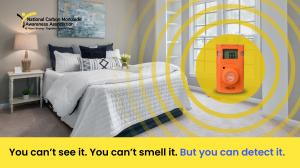November is National Carbon Monoxide Awareness Month: A Hidden Danger That Could Be Lurking at Home
The NCOAA urges the public to recognize the silent, invisible threat of CO poisoning that annually claims lives and sickens thousands across the US.
Carbon monoxide remains one of the most preventable causes of poisoning deaths in America. Too many families live without CO detector alarms installed in their homes.”
BIRMINGHAM, MI, UNITED STATES, October 29, 2025 /EINPresswire.com/ -- A home, apartment, or business fire rages. The smell is unmistakable, and the heat is overwhelming. The alarm blares, warning of imminent danger, eyes burn, and breathing is difficult as plumes of thick black smoke fill the air.— Charon McNabb, President & Founder of NCOAA
The signs of a fire are obvious and urgent. But imagine a deadly threat that gives no warning at all?
As we observe National Carbon Monoxide Awareness Month this November, the National Carbon Monoxide Awareness Association (NCOAA) urges the public to recognize the silent, invisible threat of carbon monoxide (CO) poisoning. This danger claims hundreds of lives and sickens thousands each year across the United States.
“Carbon monoxide remains one of the most preventable causes of poisoning deaths in America,” said Charon McNabb, President & Founder of NCOAA. “We’ve made progress in raising awareness, but too many families still travel without portable CO detectors and live without alarms installed in their homes. Education and prevention save lives. That’s why this month matters so much.”
Carbon monoxide is a toxic gas produced by fuel-burning devices such as furnaces, generators, fireplaces, grills, and even vehicles. Unlike fire, CO has no color, odor, or taste, making it virtually undetectable without an alarm.
CO exposure can cause both short-term and long-term health consequences. High concentrations can be fatal within minutes, while prolonged exposure to lower levels can cause chronic illness. Many states still do not require carbon monoxide alarms in homes, hotels, schools, or other places where people sleep or gather, leaving countless individuals unknowingly exposed.
Symptoms of CO poisoning can include:
● Headache, nausea, vomiting
● Dizziness and confusion
● Shortness of breath
● Weakness, fatigue, or blurred vision
● Sleepiness, loss of muscle control, and unconsciousness
Protect Yourself and Your Loved Ones: Carbon Monoxide Safety Tips
● Install CO alarms -- on each level of your home, and in your garage, shop, or man cave, especially near fuel-burning appliances and sleeping areas.
● Take a portable CO alarm when traveling -- most hotels are not required to have one.
● Know the sound -- CO alarms beep four times in a row; fire alarms beep three times. If the CO alarm sounds, get out of the home and stay out.
● Test alarms monthly, replace batteries as needed, and follow the manufacturer’s replacement schedule.
● Schedule annual inspections for furnaces, chimneys, and fireplaces.
● Use generators safely. Keep them at least 20 feet from any building, and never use them inside.
● Never heat your home with a gas oven or range.
● Ventilate your garage; don’t run vehicles inside, even with the door open.
● Keep exhaust vents clear, including your home’s appliances and your car’s tailpipe.
For more details on the dangers of carbon monoxide, visit the National Carbon Monoxide Awareness Association (NCOAA) website.
About the National Carbon Monoxide Awareness Association (NCOAA):
Celebrating 10 years strong, the National Carbon Monoxide Awareness Association (NCOAA) is a non-partisan, grassroots organization founded by a CO poisoning survivor. NCOAA partners with safety agencies, health professionals, and community organizations to raise awareness and promote stronger CO safety standards. We are united around one powerful truth: carbon monoxide poisoning is 100% preventable. That’s why we’ve set a bold but achievable goal—to eliminate CO poisoning by 2040.
This Carbon Monoxide Awareness Month, your support matters more than ever. Here’s how to help:
● Follow us on social media
● Sign up for our monthly newsletter
● Make a tax-deductible donation
● Join the CO Safety Coalition and take action in your community
● Together, we can protect more lives and end CO poisoning for good.
Adrienne Lenhoff
Buzzphoria - National Carbon Monoxide Awareness Association
email us here
Legal Disclaimer:
EIN Presswire provides this news content "as is" without warranty of any kind. We do not accept any responsibility or liability for the accuracy, content, images, videos, licenses, completeness, legality, or reliability of the information contained in this article. If you have any complaints or copyright issues related to this article, kindly contact the author above.


